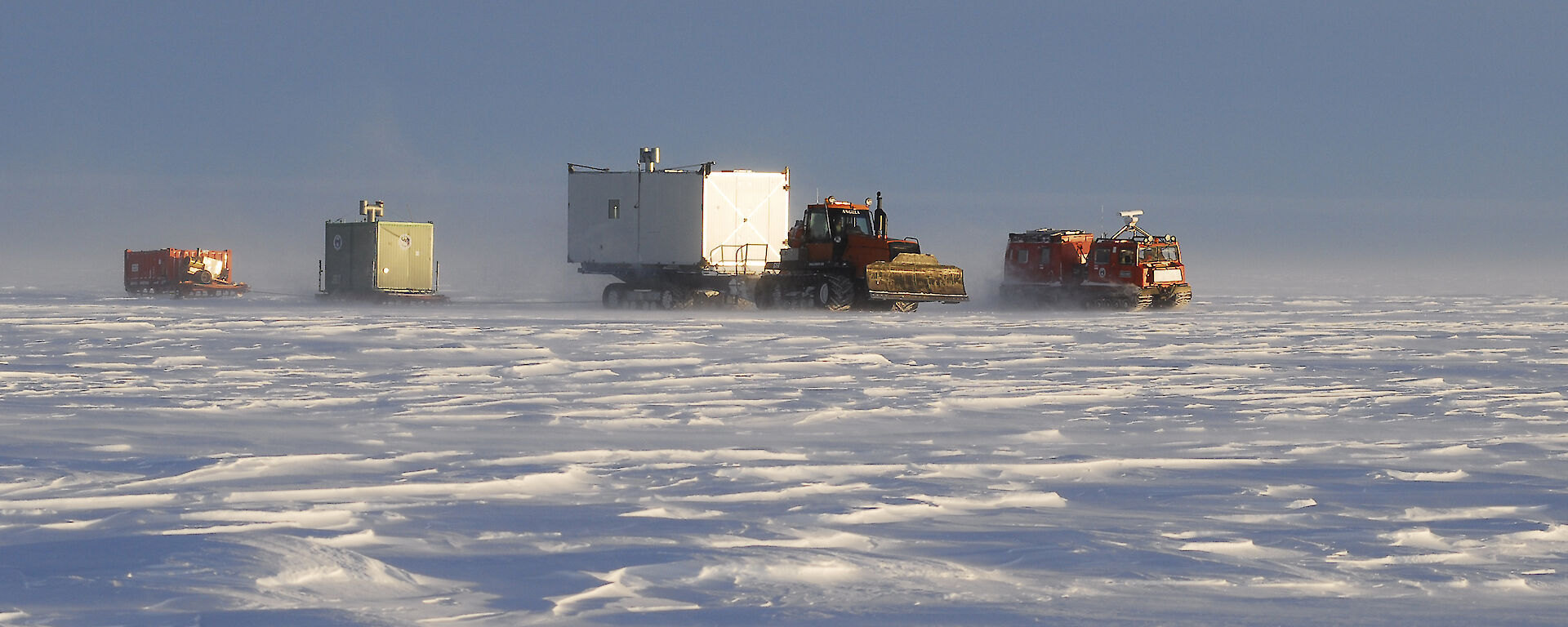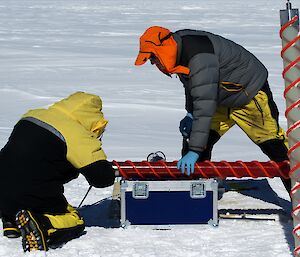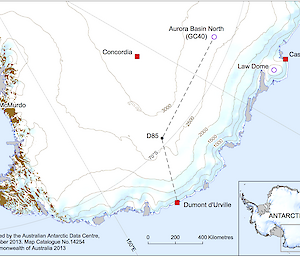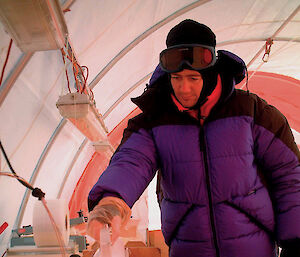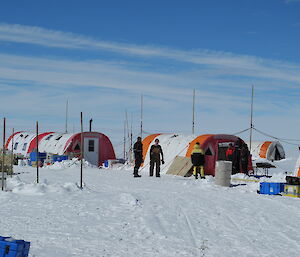An international team of scientists set out to drill a 2,000 to 3,000 year ice core climate record at Aurora Basin in east Antarctica.
Over six weeks, between December 2013 and January 2014, 24 scientists in two field teams drilled a 303 m long ice core at the remote site. The goal was to fill a major gap in an array of 2,000 year ice core climate records distributed across Antarctica.
Two smaller drills were used to recover two shallow ice cores 116 m and 103 m long spanning the past 800 to 1,000 years.
Ancient air samples extracted from the boreholes, as well as from bubbles trapped in the ice cores, help us to examine changes in atmospheric composition over time.
Dr Mark Curran, from the Australian Antarctic Division, is the Science Leader for the project.
Getting to Aurora Basin
The Aurora Basin drill site is about 550 km from Australia’s Casey station. To get the majority (26 tonnes) of the camp and drilling equipment to the site, a French team will lead a heavy vehicle traverse from Dumont d’Urville at the end of November, across some 1,300 km of the windswept and hostile icecap. Australian Antarctic Division ice core scientist Dr Tas van Ommen will also join the 14-strong French traverse team at Dumont d’Urville (follow his traverse blog).
The traverse route climbs from sea level to an altitude of 2,694 m and will take about 15 days, depending on the weather. Once at Aurora Basin, the traverse team will use a Kässbohrer (snow groomer) to prepare a skiway to enable Basler and Twin Otter aircraft to land the first of two drill teams, and the other 4 tonnes of equipment.
Once the first team of drillers arrives (including Dr Mark Curran), the French traverse team will depart. If all goes well, many of the members of the first drill team will be replaced by a second drill team half way through the season.
Ice camp
The mean annual temperature at Aurora Basin is about −44°C. However the ice coring team will be visiting in summer, when temperatures should range between −25° and −30°C on a good day.
A warm living space is therefore essential, and a large communal kitchen and living tent will form the heart of the camp. A kerosene stove will help warm this tent to about −5°C. Another large tent, the drill tent, will protect scientists from blizzard conditions outside, but it will not be heated. A range of smaller, single person, polar tents will be used for sleeping. All up, the campsite will accommodate 16 people at a time.
This light camp structure will enable the breakdown and retrieval of the full camp by air at the end of the field season, eliminating the need for a traverse exit.
Personnel
Two teams of about 16 people will be rotated through the field camp over five to six weeks, from early December 2013 to late January 2014. Some people, including Chief Investigator Dr Mark Curran, will remain on site for the full season, while others will be replaced after about 3 weeks. As well as scientists, each team will have a doctor, air and ground support officer, mechanic, and chef.
Returning ice cores to Australia
Despite the cold ambient air temperatures of between −25° and −30°C, the ice cores will still need to be stored in a sub-surface pit to protect them from warming in sunlight. This will require a large excavation to accommodate tens of cubic metres of boxed core. Over the course of the season cores will be flown back to Casey station in insulated boxes and stored at the station in refrigerators. At the end of the season the cores will be transferred to refrigerators onboard the ship, Aurora Australis, for the sea voyage back to Hobart.
Why drill ice cores?
Ice cores provide crucial information on past climate and climate processes that is key to understanding climate and predicting future change.
Antarctic ice cores, particularly, provide information from a region of the planet where we have only short observational records and a need for further insight into the role of Antarctica in the global climate system.
Australia is one of a few nations to have drilled a deep Antarctic core (to bedrock), and a leading nation among the several involved in Antarctic ice coring through the peak planning body known as the International Partnership in Ice Core Sciences (IPICS).
Despite more than two decades of international ice coring activity, there remain large gaps in our coverage of Antarctica. IPICS has identified the need for an array of ice cores covering the last 2,000 years in Antarctica, and has made this goal a priority project.
Australia has already contributed to the 2,000 year array with and ice core from Law Dome, but the Australian Antarctic Territory remains one of the large gaps in the IPICS ‘2k array’.
Ice core chemistry
The 400 m (2,000 year) and two 120 m ice cores will be used to measure a range of chemical constituents to reconstruct past climate.
The Aurora Basin team will use a field-based Picarro laser spectrometer to measure water (H2O) isotopes (different nuclear forms of oxygen and hydrogen) in the 400 m core. Ice formed under cooler conditions, for example, will contain more 16O while ice formed under warmer conditions will contain more of the heavier isotope, 18O. These isotope changes are mostly influenced by temperature, enabling scientists to infer what the temperature was when the snow originally fell. By measuring these isotopes on site, rather than in a laboratory on their return, the scientists will have a 2,000 year temperature record as soon as they leave the field.
Samples from the core will also be cut for later laboratory analysis of methanesulphonic acid (MSA). MSA is produced from the oxidation in the atmosphere of dimethylsulphide, which is itself produced by certain species of phytoplankton in the Southern Ocean. The amount of MSA in an ice core is related to the maximum extent of sea ice in the region — when there is more sea ice there is more phytoplankton activity following sea ice decay and therefore more MSA production.
One of the 120 m cores will be used purely for sulphur isotope analysis to assess the volcanic ‘forcing’ (impact) on natural climate variation over time. Similarly, carbon dioxide concentrations in the ice will be measured to assess the greenhouse gas forcing on natural climate variation while beryllium-10 measurements will give an indication of solar forcing.
Scientists from the Desert Research Institute in the United States will produce much of the fine detail climate record by measuring a range of chemical species and elements in the 400 m core. These include dust tracers such as magnesium and iron, ash from fires, seawater tracers such as sodium and bromine, and volcanic tracers such as copper and cadmium. These analyses will help date the ice core and provide information about natural aerosols and pollution levels in the recent era.
Finally, the team will extract air from the ‘firn’ ice at the top of one of the 120 m ice cores. Firn ice is unconsolidated ice that contains a lot of air space, unlike consolidated ice where air is trapped in bubbles. The extracted air will be ‘fresher’ or more modern than air trapped deep within the ice core and will provide a record of gas concentrations over recent decades (including carbon dioxide, carbon monoxide, methane, oxygen and nitrogen). This will help scientists better understand the carbon cycle and anthropogenic changes.
Why Aurora Basin?
Aurora Basin is the ideal site for the research as it has sufficient snowfall of about 13 cm of ice per year; enough to provide the first record of year-to-year changes over the past 2000 years in this region of the continent.
Aurora Basin also harbours some of the deepest ice in Antarctica – over 3 km thick. Ice this thick could be over one million years old. Data collected during the drilling of the 2000 year ice core may help scientists locate a suitable site for drilling this million year old ice core.
Collaboration
The Aurora Basin project involves 15 partner organisations contributing from six nations: Australia, China, Denmark, France Germany and the United States of America. For a list of partners see the personnel profiles.

